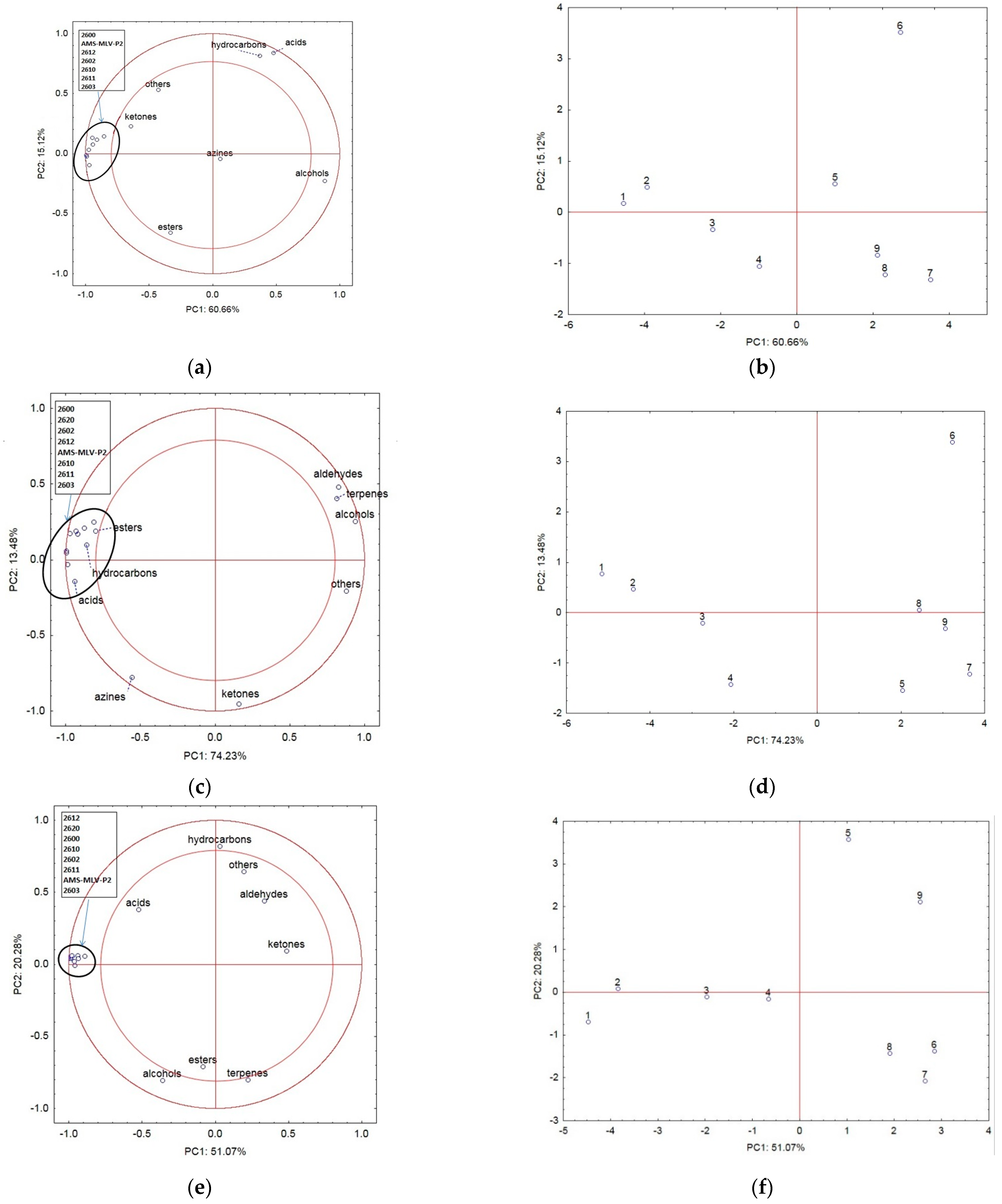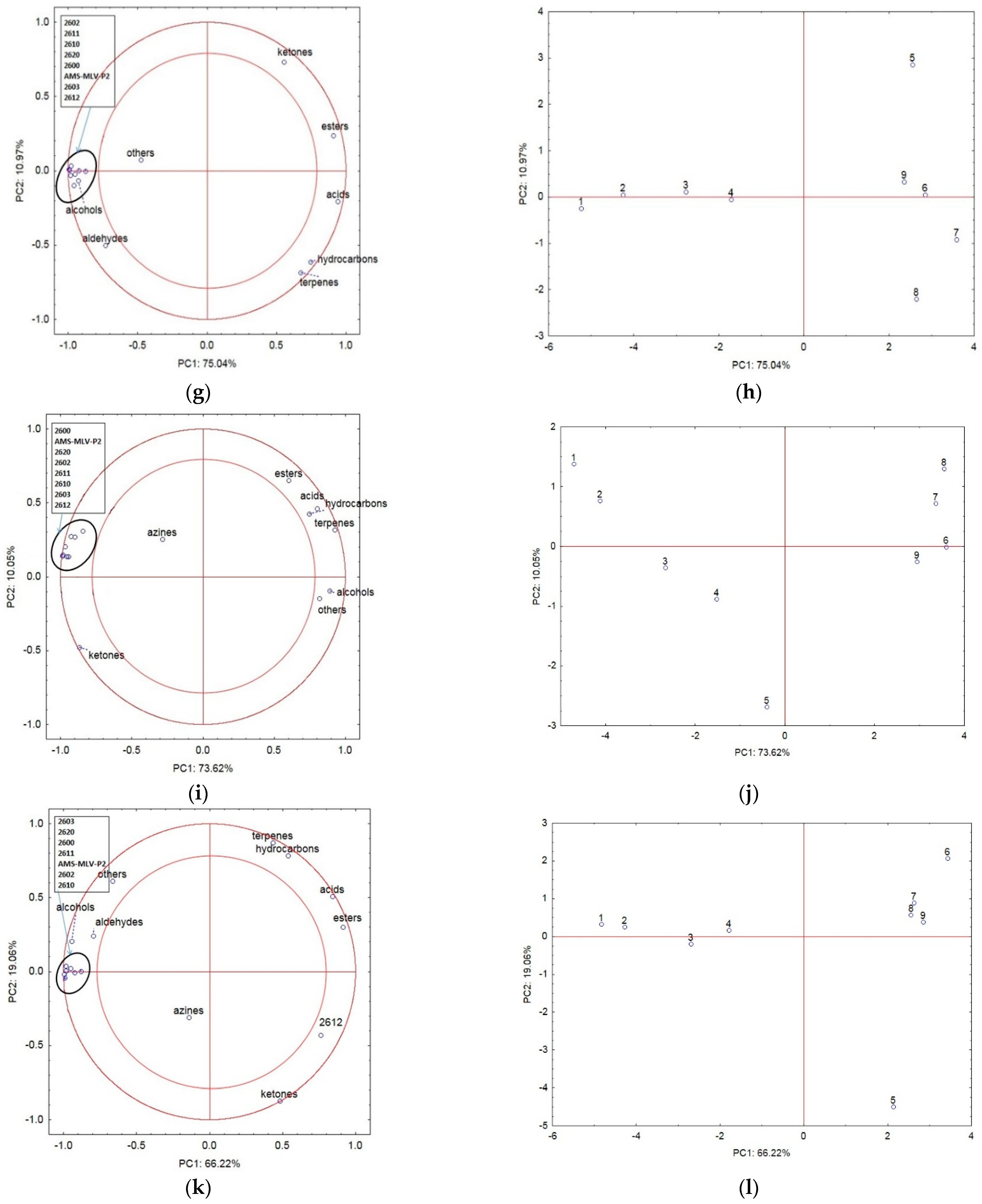Effect of the Consolidation Level on Organic Volatile Compound Emissions from Maize during Storage
Abstract
1. Introduction
2. Materials and Methods
2.1. Materials
2.2. Electronic Nose
2.3. GC–MS Analysis
2.4. Statistical Analysis
3. Results and Discussion
3.1. Electronic Nose Responses
3.2. Identification of Major Volatile Organic Compounds—GC–MS Analysis
3.3. Principal Component Analysis (PCA)
4. Conclusions
Supplementary Materials
Author Contributions
Funding
Institutional Review Board Statement
Informed Consent Statement
Data Availability Statement
Conflicts of Interest
References
- FAO. Corn Production 2020. Available online: https://www.fao.org/faostat/ (accessed on 30 August 2022).
- Foreign Agricultural Service U.S. Department of Agriculture, International Agricultural Trade Report, 6 April 2022. Available online: https://www.fas.usda.gov/data/world-agricultural-production (accessed on 29 August 2022).
- Biemond, P.C.; Stomph, T.J.; Kumar, P.L.; Struik, P.C. How maize seed systems can contribute to the control of mycotoxigenic fungal infection: A perspective. Agronomy 2021, 11, 2168. [Google Scholar] [CrossRef]
- Dinolfo, M.I.; Martínez, M.; Castañares, E.; Arata, A.F. Fusarium in maize during harvest and storage: A review of species involved mycotoxins, and management strategies to reduce contamination. Eur. J. Plant Pathol. 2022, 164, 151–166. [Google Scholar] [CrossRef]
- Alaniz Zanon, M.S.; Bossa, M.; Chiotta, M.L.; Oddino, C.; Giovanini, D.; Cardoso, M.L.; Bartosik, R.E.; Chulze, S.N. Pre-harvest strategy for reducing aflatoxine accumulation during storage of maize in Argentina. Int. J. Food Microbiol. 2022, 380, 109887. [Google Scholar] [CrossRef]
- Rejowski, K.; Iwicki, P.; Tejchman, J.; Wójcik, M. Buckling resistance of a metal column in a corrugated sheet silo-experiments and non-linear stability calculations. Thin-Walled Struct. 2023, 182, 110206. [Google Scholar] [CrossRef]
- Maragos, C.M.; Barnett, K.; Morgan, L.; Vaughan, M.M.; Sieve, K.K. Measurement of fumonisins in maize using a portable mass spectrometer. Toxins 2022, 14, 523. [Google Scholar] [CrossRef] [PubMed]
- Gergolet Diaz, D.G.; Pizzolitto, R.P.; Vázquez, C.; Usseglio, V.L.; Zunino, M.P.; Dambolena, J.S.; Zygadlo, J.A.; Merlo, C. Effects of the volatile organic compounds produced by Enterococcus spp. strains isolated from maize grain silos on Fusarium verticillioides growth and fumonisin B1 production. J. Stored Prod. Res. 2021, 93, 101825. [Google Scholar] [CrossRef]
- Odjo, S.; Palacios-Rojas, N.; Burgueño, J.; Corrado, M.; Ortner, T.; Verhulst, N. Hermetic storage technologies preserve maize seed quality loss in smallholder farming systems in Mexico. J. Stored Prod. Res. 2022, 96, 101954. [Google Scholar] [CrossRef]
- Gawrysiak-Witulska, M.; Siger, A.; Rusinek, R. Degradation of tocopherols during rapeseed storage in simulated conditions of industrial silos. Int. Agrophys. 2016, 30, 39–45. [Google Scholar] [CrossRef]
- Nielsen, J. Pressures from flowing granular solids in silos. Phil. Trans. R. Soc. Lond. A 1998, 356, 2667–2684. [Google Scholar] [CrossRef]
- Horabik, J.; Molenda, M. Physical properties granular food materials. Acta Agrophys. 2002, 74, 1–90. [Google Scholar]
- Qiao, M.; Xia, G.; Cui, T.; Xu, Y.; Gao, X.; Su, Y.; Li, Y.; Fan, H. Effect of moisture, protein, starch, soluble sugar contents and microstructure on mechanical properties of maize kernels. Food Chem. 2022, 379, 132147. [Google Scholar] [CrossRef] [PubMed]
- Babić, L.J.; Radojčin, M.; Pavkov, I.; Babić, M.; Turan, J.; Zoranović, M.; Stanišić, S. Physical properties and compression loading behavior of corn seed. Int. Agrophys. 2013, 27, 119–126. [Google Scholar] [CrossRef]
- Alimohammadi, F.; Raselch, M.; Sayyah, A.H.A.; Abbaspour-Gilandeh, Y.; Karami, H.; Sharabiani, V.R.; Fiorauanti, A.; Gancarz, M.; Findura, P.; Kwaśniewski, D. Hyperspectral imaging coupled with multivariate analysis and artificial intelligence to the classification of maize kernels. Int. Agrophys. 2022, 36, 83–91. [Google Scholar] [CrossRef] [PubMed]
- Kruszelnicka, W.; Chen, Z.; Ambrose, K. Moisture-dependent physical-mechanical properties of maize, rice and soybeans as related to handling and processing. Materials 2022, 15, 8729. [Google Scholar] [CrossRef]
- Gancarz, M.; Wawrzyniak, J.; Gawrysiak-Witulska, M.; Wiącek, D.; Nawrocka, A.; Tadla, M.; Rusinek, R. Application of electronic nose with MOS sensors to prediction of rapeseed quality. Measurement 2017, 103, 227–234. [Google Scholar] [CrossRef]
- Rusinek, R.; Jeleń, H.; Malaga-Toboła, U.; Molenda, M.; Gancarz, M. Influence of changes in the level of volatile compounds emitted during rapeseed quality degradation on the reaction of MOS type sensor-array. Sensors 2020, 20, 3135. [Google Scholar] [CrossRef]
- Manchungo, C.W.; Berna, A.Z.; McNevin, D.; Wang, R.; Harvey, J.; Trowell, S. Evaluation of performance of metal oxide electronic nose for detection of aflatoxin in artificially and naturally contaminated maize. Sens. Actuators B Chem. 2023, 381, 133446. [Google Scholar] [CrossRef]
- Ottoboni, M.; Pinotti, L.; Tretola, M.; Giromini, C.; Fusi, E.; Rebucci, R.; Grillo, M.; Tassoni, L.; Foresta, S.; Gastaldello, S.; et al. Combining E-nose and lateral flow immunoassays (LFIAs) for rapid occurrence/co-occurrence aflatoxin and fumonisin detection in maize. Toxins 2018, 10, 416. [Google Scholar] [CrossRef]
- Janik, E.; Niemcewicz, M.; Podogrocki, M.; Ceremuga, M.; Gorniak, L.; Stela, M.; Bijak, M. The existing methods and novel approaches in mycotoxins’ detection. Molecules 2021, 26, 3981. [Google Scholar] [CrossRef]
- Gawrysiak-Witulska, M.; Rudzińska, M.; Rusinek, R.; Gancarz, M.; Siger, A. Changes in phytosterol contents during rape seed storage under conditions simulating industrial silos. J. Stored Prod. Res. 2020, 88, 101687. [Google Scholar] [CrossRef]
- Stasiak, M.; Rusinek, R.; Molenda, M.; Fornal, J.; Błaszczak, W. Effect of potato starch modification on mechanical parameters and granules morphology. J. Food Eng. 2011, 102, 154–162. [Google Scholar] [CrossRef]
- Śmigała, M.; Winiarczyk, K.; Dąbrowska, A.; Domaciuk, M.; Gancarz, M. Determination of the Influence of Mechanical Properties of Capsules and Seeds on the Susceptibility to Feeding of Mononychus pubctumalbum in Endangered Plant Species Iris aphylla L. and Iris sibirica L. Sensors 2021, 21, 2209. [Google Scholar] [CrossRef] [PubMed]
- Gancarz, M.; Dobrzański, B., Jr.; Malaga-Toboła, U.; Tabor, S.; Combrzyński, M.; Ćwikła, D.; Strobel, W.R.; Oniszczuk, A.; Karami, H.; Darvishi, Y.; et al. Impact of Coffee Bean Roasting on the Content of Pyridines Determined by Analysis of Volatile Organic Compounds. Molecules 2022, 27, 1559. [Google Scholar] [CrossRef] [PubMed]
- Lippolis, V.; Pascale, M.; Cervellieri, S.; Damascelli, A.; Visconti, A. Screening of deoxynivalenol contamination in durum wheat by MOS-based electronic nose and identification of the relevant pattern of volatile compounds. Food Control 2014, 37, 263–271. [Google Scholar] [CrossRef]
- Rusinek, R.; Gawrysiak-Witulska, M.; Siger, A.; Oniszczuk, A.; Ptaszyńska, A.A.; Knaga, J.; Malaga-Toboła, U.; Gancarz, M. Effect of Supplementation of Flour with Fruit Fiber on the Volatile Compound Profile in Bread. Sensors 2021, 21, 2812. [Google Scholar] [CrossRef] [PubMed]
- Gu, S.; Wang, J.; Wang, Y. Early discrimination and growth tracking of Aspergillus spp. contamination in rice kernels using electronic nose. Food Chem. 2019, 292, 325–335. [Google Scholar] [CrossRef]
- Rusinek, R.; Dobrzański, B., Jr.; Oniszczuk, A.; Gawrysiak-Witulska, M.; Siger, A.; Karami, H.; Ptaszyńska, A.A.; Żytek, A.; Kapela, K.; Gancarz, M. How to Identify Roast Defects in Coffee Beans Based on the Volatile Compound Profile. Molecules 2022, 27, 8530. [Google Scholar] [CrossRef] [PubMed]
- Yin, Y.; Hao, Y.; Yu, H. Identification method for different moldy degrees of maize using electronic nose coupled with multi-features fusion. Nongye Gongcheng Xuebao/Trans. Chin. Soc. Agric. Eng. 2016, 32, 254–260. [Google Scholar] [CrossRef]
- Olsson, J.; BÖrjesson, T.; Lundstedt, T.; Schnürer, J. Detection and quantification of ochratoxin A and deoxynivalenol in barley grains by GC-MS and electronic nose. Int. J. Food Microbiol. 2002, 72, 203–214. [Google Scholar] [CrossRef]
- Rodríguez-Carrasco, Y.; Moltó, J.C.; Berrada, H.; Mañes, J. A survey of trichothecenes, zearalenone and patulin in milled grain-based products using GC-MS/MS. Food Chem. 2014, 146, 212–219. [Google Scholar] [CrossRef]
- Zhang, J.; Zhang, B.; Dong, J.; Tian, Y.; Lin, Y.; Fang, G.; Wang, S. Identification of mouldy rice using an electronic nose combined with SPME-GC/MS. J. Stored Prod. Res. 2022, 95, 101921. [Google Scholar] [CrossRef]
- Lippolis, V.; Cervellieri, S.; Damascelli, A.; Pascale, M.; Di Gioia, A.; Longobardi, F.; De Girolamo, A. Rapid prediction of deoxynivalenol contamination in wheat bran by MOS-based electronic nose and characterization of the relevant pattern of volatile compounds. J. Sci. Food Agric. 2018, 98, 4955–4962. [Google Scholar] [CrossRef]
- Worku, A.F.; Kalsa, K.K.; Abera, M.; Tenagashaw, M.W.; Habtu, N.G. Evaluation of various maize storage techniques on total aflatoxins prevalence and nutrient preservation. J. Stored Prod. Res. 2022, 95, 101913. [Google Scholar] [CrossRef]
- Jia, F.; Yang, J.; Wang, J.; Cao, Y.; Li, Y. Analysis of volatile aroma components in grains of high quality edible corn. Sci. Technol. Food Ind. 2022, 43, 304–310. [Google Scholar] [CrossRef]
- Usseglio, V.L.; Pizzolitto, R.P.; Rodriguez, C.; Zunino, M.P.; Zygadlo, J.A.; Areco, V.A.; Dambolena, J.S. Volatile organic compounds from the interaction between Fusarium verticillioides and maize kernels as a natural repellents of Sitophilus zeamais. J. Stored Prod. Res. 2017, 73, 109–114. [Google Scholar] [CrossRef]


Disclaimer/Publisher’s Note: The statements, opinions and data contained in all publications are solely those of the individual author(s) and contributor(s) and not of MDPI and/or the editor(s). MDPI and/or the editor(s) disclaim responsibility for any injury to people or property resulting from any ideas, methods, instructions or products referred to in the content. |
© 2023 by the authors. Licensee MDPI, Basel, Switzerland. This article is an open access article distributed under the terms and conditions of the Creative Commons Attribution (CC BY) license (https://creativecommons.org/licenses/by/4.0/).
Share and Cite
Żytek, A.; Rusinek, R.; Oniszczuk, A.; Gancarz, M. Effect of the Consolidation Level on Organic Volatile Compound Emissions from Maize during Storage. Materials 2023, 16, 3066. https://doi.org/10.3390/ma16083066
Żytek A, Rusinek R, Oniszczuk A, Gancarz M. Effect of the Consolidation Level on Organic Volatile Compound Emissions from Maize during Storage. Materials. 2023; 16(8):3066. https://doi.org/10.3390/ma16083066
Chicago/Turabian StyleŻytek, Aleksandra, Robert Rusinek, Anna Oniszczuk, and Marek Gancarz. 2023. "Effect of the Consolidation Level on Organic Volatile Compound Emissions from Maize during Storage" Materials 16, no. 8: 3066. https://doi.org/10.3390/ma16083066
APA StyleŻytek, A., Rusinek, R., Oniszczuk, A., & Gancarz, M. (2023). Effect of the Consolidation Level on Organic Volatile Compound Emissions from Maize during Storage. Materials, 16(8), 3066. https://doi.org/10.3390/ma16083066








